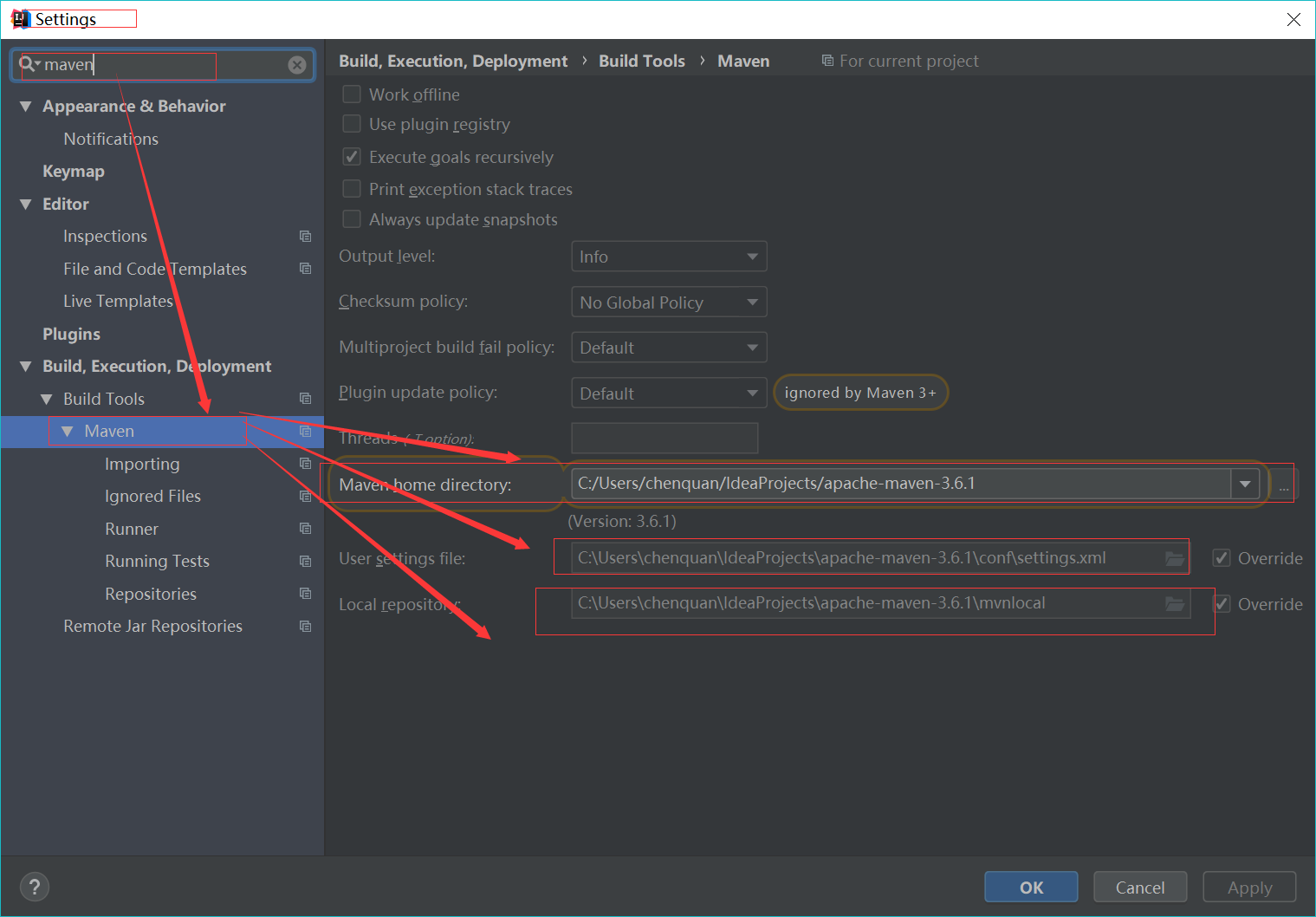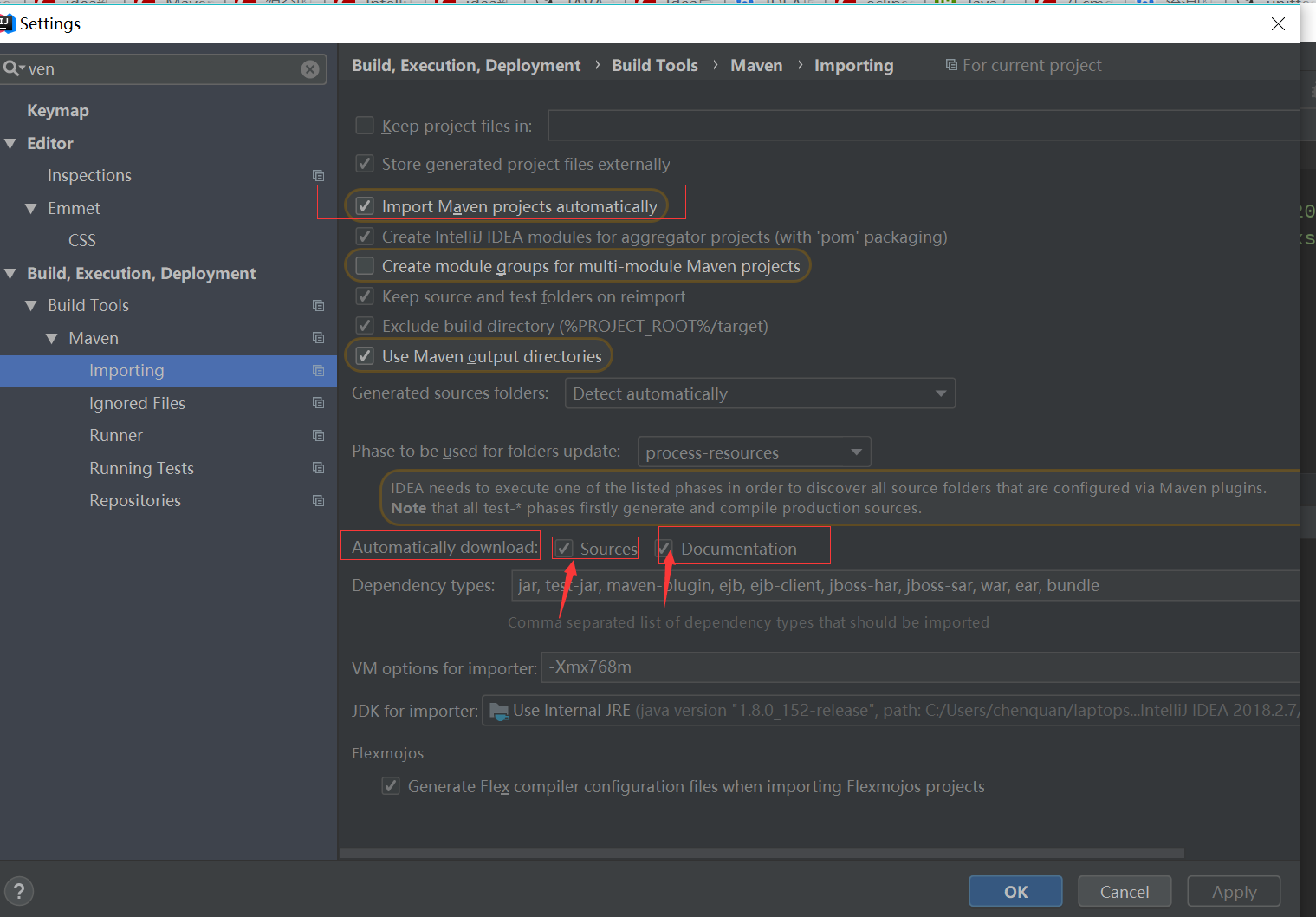windows maven配置
<?xml version="1.0" encoding="UTF-8"?> <!--
Licensed to the Apache Software Foundation (ASF) under one
or more contributor license agreements. See the NOTICE file
distributed with this work for additional information
regarding copyright ownership. The ASF licenses this file
to you under the Apache License, Version 2.0 (the
"License"); you may not use this file except in compliance
with the License. You may obtain a copy of the License at http://www.apache.org/licenses/LICENSE-2.0 Unless required by applicable law or agreed to in writing,
software distributed under the License is distributed on an
"AS IS" BASIS, WITHOUT WARRANTIES OR CONDITIONS OF ANY
KIND, either express or implied. See the License for the
specific language governing permissions and limitations
under the License.
--> <!--
| This is the configuration file for Maven. It can be specified at two levels:
|
| 1. User Level. This settings.xml file provides configuration for a single user,
| and is normally provided in ${user.home}/.m2/settings.xml.
|
| NOTE: This location can be overridden with the CLI option:
|
| -s /path/to/user/settings.xml
|
| 2. Global Level. This settings.xml file provides configuration for all Maven
| users on a machine (assuming they're all using the same Maven
| installation). It's normally provided in
| ${maven.conf}/settings.xml.
|
| NOTE: This location can be overridden with the CLI option:
|
| -gs /path/to/global/settings.xml
|
| The sections in this sample file are intended to give you a running start at
| getting the most out of your Maven installation. Where appropriate, the default
| values (values used when the setting is not specified) are provided.
|
|-->
<settings xmlns="http://maven.apache.org/SETTINGS/1.0.0"
xmlns:xsi="http://www.w3.org/2001/XMLSchema-instance"
xsi:schemaLocation="http://maven.apache.org/SETTINGS/1.0.0 http://maven.apache.org/xsd/settings-1.0.0.xsd">
<!-- localRepository
| The path to the local repository maven will use to store artifacts.
|
| Default: ${user.home}/.m2/repository
<localRepository>/path/to/local/repo</localRepository>
-->
<localRepository>C:/Users/chenquan/IdeaProjects/apache-maven-3.6.1/mvnlocal</localRepository>
<!-- interactiveMode
| This will determine whether maven prompts you when it needs input. If set to false,
| maven will use a sensible default value, perhaps based on some other setting, for
| the parameter in question.
|
| Default: true
<interactiveMode>true</interactiveMode>
--> <!-- offline
| Determines whether maven should attempt to connect to the network when executing a build.
| This will have an effect on artifact downloads, artifact deployment, and others.
|
| Default: false
<offline>false</offline>
--> <!-- pluginGroups
| This is a list of additional group identifiers that will be searched when resolving plugins by their prefix, i.e.
| when invoking a command line like "mvn prefix:goal". Maven will automatically add the group identifiers
| "org.apache.maven.plugins" and "org.codehaus.mojo" if these are not already contained in the list.
|-->
<pluginGroups>
<!-- pluginGroup
| Specifies a further group identifier to use for plugin lookup.
<pluginGroup>com.your.plugins</pluginGroup>
-->
</pluginGroups> <!-- proxies
| This is a list of proxies which can be used on this machine to connect to the network.
| Unless otherwise specified (by system property or command-line switch), the first proxy
| specification in this list marked as active will be used.
|-->
<proxies>
<!-- proxy
| Specification for one proxy, to be used in connecting to the network.
|
<proxy>
<id>optional</id>
<active>true</active>
<protocol>http</protocol>
<username>proxyuser</username>
<password>proxypass</password>
<host>proxy.host.net</host>
<port>80</port>
<nonProxyHosts>local.net|some.host.com</nonProxyHosts>
</proxy>
-->
<proxy>
<id>optional</id>
<active>true</active>
<protocol>http</protocol>
<username></username>
<password></password>
<host>proxy.webank.com</host>
<port>8484</port>
<nonProxyHosts></nonProxyHosts>
</proxy> </proxies> <!-- servers
| This is a list of authentication profiles, keyed by the server-id used within the system.
| Authentication profiles can be used whenever maven must make a connection to a remote server.
|-->
<servers>
<!-- server
| Specifies the authentication information to use when connecting to a particular server, identified by
| a unique name within the system (referred to by the 'id' attribute below).
|
| NOTE: You should either specify username/password OR privateKey/passphrase, since these pairings are
| used together.
|
<server>
<id>deploymentRepo</id>
<username>repouser</username>
<password>repopwd</password>
</server>
--> <!-- Another sample, using keys to authenticate.
<server>
<id>siteServer</id>
<privateKey>/path/to/private/key</privateKey>
<passphrase>optional; leave empty if not used.</passphrase>
</server>
-->
</servers> <!-- mirrors
| This is a list of mirrors to be used in downloading artifacts from remote repositories.
|
| It works like this: a POM may declare a repository to use in resolving certain artifacts.
| However, this repository may have problems with heavy traffic at times, so people have mirrored
| it to several places.
|
| That repository definition will have a unique id, so we can create a mirror reference for that
| repository, to be used as an alternate download site. The mirror site will be the preferred
| server for that repository.
|-->
<mirrors>
<!-- mirror
| Specifies a repository mirror site to use instead of a given repository. The repository that
| this mirror serves has an ID that matches the mirrorOf element of this mirror. IDs are used
| for inheritance and direct lookup purposes, and must be unique across the set of mirrors.
|
<mirror>
<id>mirrorId</id>
<mirrorOf>repositoryId</mirrorOf>
<name>Human Readable Name for this Mirror.</name>
<url>http://my.repository.com/repo/path</url>
</mirror>
-->
<mirror>
<id>alimaven</id>
<name>aliyun maven</name>
<url>http://maven.aliyun.com/nexus/content/groups/public/</url>
<mirrorOf>central</mirrorOf>
</mirror>
</mirrors> <!-- profiles
| This is a list of profiles which can be activated in a variety of ways, and which can modify
| the build process. Profiles provided in the settings.xml are intended to provide local machine-
| specific paths and repository locations which allow the build to work in the local environment.
|
| For example, if you have an integration testing plugin - like cactus - that needs to know where
| your Tomcat instance is installed, you can provide a variable here such that the variable is
| dereferenced during the build process to configure the cactus plugin.
|
| As noted above, profiles can be activated in a variety of ways. One way - the activeProfiles
| section of this document (settings.xml) - will be discussed later. Another way essentially
| relies on the detection of a system property, either matching a particular value for the property,
| or merely testing its existence. Profiles can also be activated by JDK version prefix, where a
| value of '1.4' might activate a profile when the build is executed on a JDK version of '1.4.2_07'.
| Finally, the list of active profiles can be specified directly from the command line.
|
| NOTE: For profiles defined in the settings.xml, you are restricted to specifying only artifact
| repositories, plugin repositories, and free-form properties to be used as configuration
| variables for plugins in the POM.
|
|-->
<profiles>
<!-- profile
| Specifies a set of introductions to the build process, to be activated using one or more of the
| mechanisms described above. For inheritance purposes, and to activate profiles via <activatedProfiles/>
| or the command line, profiles have to have an ID that is unique.
|
| An encouraged best practice for profile identification is to use a consistent naming convention
| for profiles, such as 'env-dev', 'env-test', 'env-production', 'user-jdcasey', 'user-brett', etc.
| This will make it more intuitive to understand what the set of introduced profiles is attempting
| to accomplish, particularly when you only have a list of profile id's for debug.
|
| This profile example uses the JDK version to trigger activation, and provides a JDK-specific repo.
<profile>
<id>jdk-1.4</id> <activation>
<jdk>1.4</jdk>
</activation> <repositories>
<repository>
<id>jdk14</id>
<name>Repository for JDK 1.4 builds</name>
<url>http://www.myhost.com/maven/jdk14</url>
<layout>default</layout>
<snapshotPolicy>always</snapshotPolicy>
</repository>
</repositories>
</profile>
--> <!--
| Here is another profile, activated by the system property 'target-env' with a value of 'dev',
| which provides a specific path to the Tomcat instance. To use this, your plugin configuration
| might hypothetically look like:
|
| ...
| <plugin>
| <groupId>org.myco.myplugins</groupId>
| <artifactId>myplugin</artifactId>
|
| <configuration>
| <tomcatLocation>${tomcatPath}</tomcatLocation>
| </configuration>
| </plugin>
| ...
|
| NOTE: If you just wanted to inject this configuration whenever someone set 'target-env' to
| anything, you could just leave off the <value/> inside the activation-property.
|
<profile>
<id>env-dev</id> <activation>
<property>
<name>target-env</name>
<value>dev</value>
</property>
</activation> <properties>
<tomcatPath>/path/to/tomcat/instance</tomcatPath>
</properties>
</profile>
-->
</profiles> <!-- activeProfiles
| List of profiles that are active for all builds.
|
<activeProfiles>
<activeProfile>alwaysActiveProfile</activeProfile>
<activeProfile>anotherAlwaysActiveProfile</activeProfile>
</activeProfiles>
-->
</settings>
1.环境变量: %mavenhome%/bin添加到path
2.新建本地mavenlocal仓库
3.修改setting.xml(1。修改仓库地址必须2.修改maven下载源可选,3.修改代理可选)
4.配置maven project maven引用

5.mvn 环境验证:
mvn -version
C:\Users\ch\IdeaProjects\testrmb>mvn -version
Apache Maven 3.6.1 (d66c9c0b3152b2e69ee9bac180bb8fcc8e6af555; 2019-04-05T03:00:29+08:00)
Maven home: C:\Users\chenquan\IdeaProjects\apache-maven-3.6.1\bin\..
Java version: 1.8.0_65, vendor: Oracle Corporation, runtime: C:\Program Files (x86)\Java\jdk1.8.0_65\jre
Default locale: zh_CN, platform encoding: GBK
OS name: "windows 10", version: "10.0", arch: "x86", family: "windows"
6.其他设置:自动更新pom导入denpendence,下载依赖jar

下载maven3.6地址:http://maven.apache.org/download.cgi
windows maven配置的更多相关文章
- 在 Windows 中配置Maven
访问http://maven.apache.org/ 点击左侧的导航栏,Download 跳转到下载maven的页面,往下滚动,看到 Files 处,选择apache-maven-3.3.9-bin- ...
- Maven 配置 Selenium + testNG + reportNG 运行环境
.markdown-preview:not([data-use-github-style]) { padding: 2em; font-size: 1.2em; color: rgb(56, 58, ...
- jdk配置及maven配置
jdk配置及maven配置 >>>>>>>>>>>>>>>>>>>>>&g ...
- Ubuntu下Maven配置与Maven项目创建教程
一. Ubuntu下Maven配置 windows下Maven配置参考http://www.cnblogs.com/LexMoon/p/JavaMaven.html ubuntu下Maven地址htt ...
- maven配置详解
什么是pom? pom作为项目对象模型.通过xml表示maven项目,使用pom.xml来实现.主要描述了项目:包括配置文件:开发者需要遵循的规则,缺陷管理系统,组织和licenses,项目的 ...
- maven配置(安装&使用&私服)文档
1.Maven 环境搭建 Maven 是一个基于 Java 的工具,所以要做的第一件事情就是安装 JDK. 系统要求 项目 要求 JDK Maven 3.3 要求 JDK 1.7 或以上 Maven ...
- Maven配置本地仓库
当我们在myeclipse中update maven时可能会报错User setting file does not exist C:\Users\lenevo\.m2\setting.xml,以致于 ...
- jee-oxygen版eclipse的安装与卸载 maven配置
Eclipse 是一个开放源代码的.基于Java的可扩展开发平台,是大部分JAVA编程学习者入门的编程工具.Eclipse 是开发java的一个工具,Eclipse需要JDK中的JRE支持才能启动,所 ...
- maven配置环境
今天初学maven,先学习一下如何在windows下面配置maven,当然你要先配置好jdk的环境. 第一步,上官网下载maven插件,网址是:点击打开链接 第二步,解压文件夹,放在某一个盘符下,我是 ...
随机推荐
- 数据库之一、数据库简介及SQL概要
1.数据库简介: 数据库(Database,DB)是一个长期存储在计算机内的.有组织的.有共享的.统一管理的数据集合.简单来讲就是可以放大量数据的地方.管理数据库的计算机系统称为数据库管理系统(Dat ...
- Bayer Pattern
在刚加入工作的时候,听到最多的就是RGGB Bayer Pattern.在之前的接触中,一直默认一张图片的每个像素点有RGB三个分量,那“RGGB Bayer Pattern”究竟是什么意思.在网上查 ...
- MVC5+EF6 入门完整教程5 :UI的一些改造
https://www.cnblogs.com/miro/p/4095165.html 上篇文章介绍了EF实现CRUD及一些基本的Html Helpers. 这次我们将会对之前的内容进行一些修改和重构 ...
- C++-POJ1017-Packets
贪心算法,思路见代码 本来想搜索,结果有O(1)的算法,我佛了 其实每一种6x6的方案可以打表预处理,然后dp or search 但是既然可以贪心何乐而不为呢? #include <set&g ...
- js判断有无属性及新添属性
1.Object 判断有无新属性 obj.hasOwnProperty(propertyName) //有无指定属性propertyName Object.keys(obj) ...
- 安装java jdk环境jdk1.8
1) yum 安装java jdk 1.8 * -y 验证java [root@localhost local]# java -version openjdk version "1.8.0_ ...
- C语言数据结构——第一章 数据结构的概念
一.数据结构的基本概念 1.1-数据结构是什么? 数据结构是计算机存储和组织数据的方式.数据结构是指相互之间存在一种或多种特定关系的数据元素的集合.一般情况下,精心选择的数据结构可以带来更高的运行或者 ...
- 使用vs进行Nuget打包时的LicenseExpression填写示例参考
新版的nuget包 PackageLicense 这样写 最近编译类库项目的时候发现总是有个 licenseUrl 的警告,警告信息如下: warning NU5125: The 'licenseUr ...
- php提供下载服务实例
两个步骤:1,通过header头信息告诉浏览器,我给你回应的是一个附件请接收 2,通过php读取下载的文件的内容并返回 前端 <!DOCTYPE html> <html lang=& ...
- ubuntu 下的ftp详细配置
FTP(文件传输协议)是一个较老且最常用的标准网络协议,用于在两台计算机之间通过网络上传/下载文件.然而, FTP 最初的时候并不安全,因为它仅通过用户凭证(用户名和密码)传输数据,没有进行加密. 警 ...
